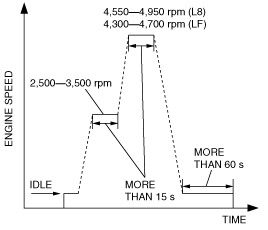OBD DRIVE MODE [L8, LF]
id0102b1815800
• Performing the Drive Mode inspects the OBD system for proper operation. The Drive Mode must be performed to ensure that no additional DTCs are present.
• During Drive Mode, the following systems are inspected:
-
― A/F sensor
― HO2S
― A/F sensor heater
― HO2S heater
― TWC
-
Caution
-
• While performing the Drive Mode, always operate the vehicle in a safe and lawful manner.
• When the M-MDS is used to observe or monitor system conditions while driving, be sure to have another technician with you, or record the data in the M-MDS using the PID/DATA MONITOR AND RECORD function and inspect later.
-
Note
-
• Vehicle speed and engine speed detected by the PCM may differ from that indicated by the speedometer and tachometer. Use the M-MDS to monitor vehicle speed.
• If the OBD system inspection is not completed during the Drive Mode, the following causes are considered:
-
― The OBD system detects the malfunction.
― The Drive Mode procedure is not completed correctly.
• Disconnecting the battery will reset the memory. Do not disconnect the battery during and after Drive Mode.
• The M-MDS can be used at anytime through the course of Drive Mode to monitor the completion condition. Monitoring can be done by viewing the ON‐BOARD SYSTEM READINESS menu.
Mode 01 (PCM Adaptive Memory Production Drive Mode)
-
Note
-
• The PCM adaptive memory condition can be confirmed with RFCFLAG PID.
• If the RFCFLAG PID is ON, the PCM adaptive memory procedure drive mode is not necessary, because the PCM already has adaptive memory.
• If the RFCFLAG PID is OFF, the PCM adaptive memory procedure drive should be performed before A/F sensor heater, HO2S heater, A/F sensor, HO2S, and TWC repair verification drive mode.
1. Start the engine and warm it up completely.
2. Verify the following conditions and correct if necessary:
-
• All accessory loads (A/C, headlights, blower fan, rear window defroster) are off.
3. Perform no load racing at the engine speed shown in the graph, then idle the engine for more than 60 s after the cooling fan has stopped. If possible, monitor RPM PID for engine speed during this procedure.
4. Turn ignition switch off then to the ON position again.
5. Access the RFCFLAG PID to confirm the PCM adaptive memory conditions. If the RFCFLAG PID is ON, the PCM adaptive memory procedure drive is completed.
6. If the RFCFLAG PID is still OFF, go back to Step 1.
Mode 03 (A/F Sensor Heater, HO2S Heater, A/F Sensor, HO2S and TWC Repair Verification Drive Mode)
1. Access the RFCFLAG PID to confirm PCM adaptive memory condition. If RFCFLAG PID is OFF, perform the PCM adaptive memory procedure drive first.
2. If RFCFLAG PID is ON, start the engine and warm it up completely.
3. Verify all accessory loads (A/C, headlights, blower fan, rear window defroster) are off.
4. Drive the vehicle as shown in the graph. The driving conditions before driving at constant speed are not specified.
5. Stop the vehicle and access ON BOARD SYSTEM READINESS menu of GENERIC OBD FUNCTION to verify the OBD monitoring status.
-
• If completed, the OBD monitoring status items change from non-completed to completed.
• If not completed, turn the ignition switch off then repeat from Step 4.
6. Access DIAGNOSTIC MONITORING TEST RESULTS menu of GENERIC OBD FUNCTIONS to verify the monitor results.
-
• If detected values are not within the specification, repair has not been completed.
7. Verify no DTCs are available.
